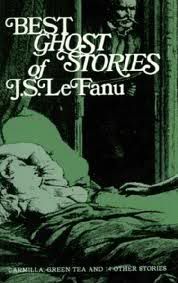Day Three
Irish Gothic
Joseph Sheridan Le Fanu
No need to worry that Irish Short Story week will be dull. Not with writers like Joseph Sheridan Le Fanu (he is descended from Huguenots driven from France to Ireland in the 16th century) bringing his Carmilla, the lesbian vampire (and a co-host for Irish Short Story Week), ghosts, and demon lovers.
Joseph Sheridan Le Fanu (1814 to 1873-Dublin) is considered a leading writer of 19th century Ghost
 |
| "Joseph, thanks for creating me and welcome to Irish Short Story Week" Carmilla |
A a deep seated belief in the supernatural seems to be an element in the Irish Short Story. Alongside the beliefs sanctioned by The Church is vast structure of beliefs in fairies, witches, evil omens, leprechauns and much more. This supernatural world is imposed on the mundane one we appear to live in. Historians might tell us that such belief structures are often found among the powerless peoples in colonized countries as a form of coping with their frustration with their situation.
Le Fanu's prose style does not at all feel old fashioned or arcane to me. Much of the history and pain of the common Irish country people is wonderfully shown in "The Child Who Was Stolen by Fairies".
The story is short and beautifully told and you can read it if you want in just a few minutes so I will not say much of the plot. The story is very Gothic, very atmospheric and very scary. A mysterious carriage, more beautiful than anyone has ever seen, is passing through the village. When young Billie comes out to see it, a beautiful women beckons him into the carriage with an apple. As the children look into the carriage the shadows a horribly ugly woman with face that would scare the devil sitting next to the beautiful woman. Billy gets in the carriage. His mother is driven to great despair as she fears Billie is lost forever. Once and a while he seems to appear at the door to her hut, her other children say they have seen him briefly in the village. Then he disappears for years. One day the mother returns and sees him in her house for sure. He is dressed in the worst rags, is filthy dirty, and looks starved. As the mother rushes to him, he disappears never to be seen again. I think this story is in part about how parents tried to cope with the starvation of their children in the great Irish famines of the 19th century in which millions died.
"Stories of Lough Guir" is set in the old manors house owned by two sisters in their 60s. The sisters are considered to local experts on supernatural happenings in their area. They in turn narrate four stories. Each of the stories is a lot of fun. They show how very pervasive the supernatural was in Ireland in the 19th century. Every event of any seeming import was caused by or influenced by an unseen "small person".
entLe Fanu was a very prolific writer. He is considered among the very best 19th century writers of Ghost and supernatural stories. I will be reading more of his work.
Please feel free to join in -just post on one Irish Short Story, and leave me a comment with a link.
 |
| "Welcome to all to Irish Short Story Week" Rory O' Hallorhan |








3 comments:
Thanks for the very informative post. Learned about a new author today!
I am going to have to read these tomorrow. Here's my post on Oscar Wilde's "The Canterville Ghost" - thanks for hosting this!
I did a posting on Le Fanu today. Here it is. I'm really having a lot of fun exploring all of these Irish authors!
Post a Comment